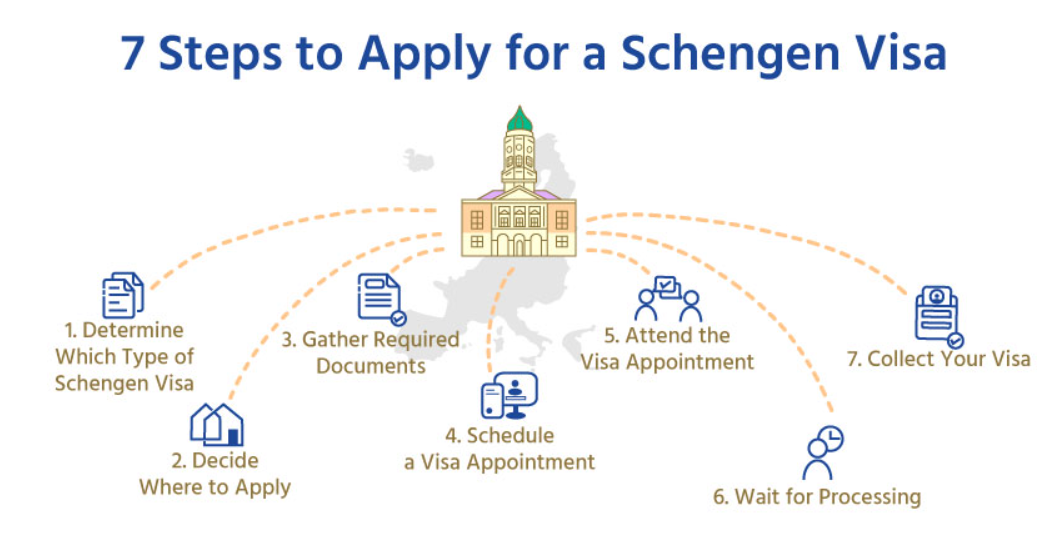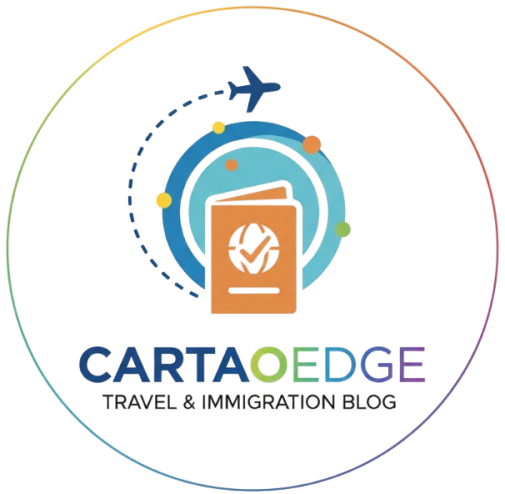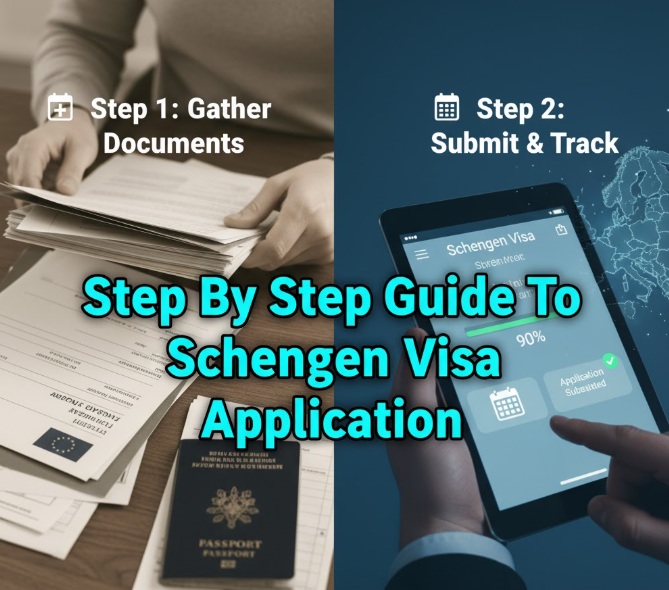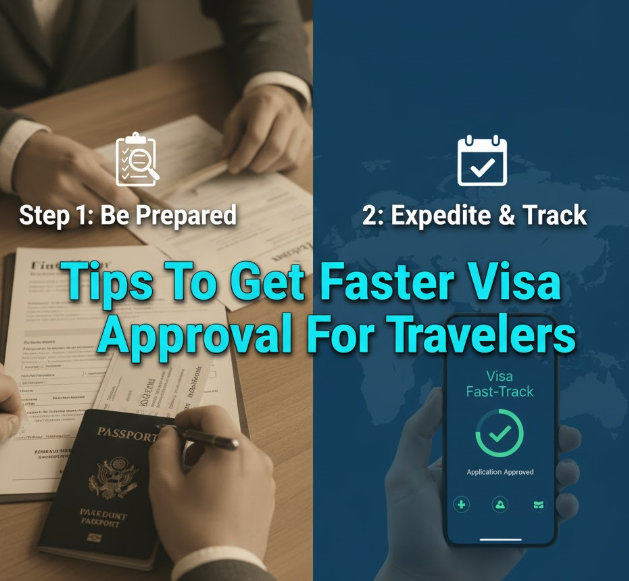The Comprehensive Guide to Your Schengen Visa: From Documents to Approval
Ready for a trip to some of the most beautiful places in Europe? And whether you’re imagining Paris’s Eiffel Tower, Rome’s ancient Colosseum or the bucolic canals of Amsterdam, chances are good you may need a Schengen visa. This one visa gives you access to 29 countries in Europe, which is why it’s considered the most useful travel document you can get. But if you don’t know where to begin, the process can be daunting.
This guide simplifies the process of applying for a Schengen visa step by step, by changing each bit of this game into an easy to follow task. By working through this road map, you will know just what forms you need, how to correctly complete the application and what to expect during your visa interview. Let’s take your European vacation from a far-off dream to a confirmed reality.
Why is the Schengen Visa So Unique?
But before we jump into the application process, let’s talk about what you’re applying for here. The Schengen visa enables you to move around 29 European countries without applying for individual visas in all the nations. These nations have abolished their interior borders, forming a single travel area.
Among the countries within the Schengen Area are France, Germany, Italy, Spain, Greece and Switzerland. Carrying with one visa, you can jump from Barcelona’s beach to a Berlin museum without additional paperwork. The most common type of visa tourists apply for is the short-stay Schengen transit visa which allows the holder up to 90 days within a half year.
Deciding Which Embassy to Contact
Several applicants are confused regarding where they should lodge their visa application. The rule is simple: Apply at the embassy or consulate of your primary destination country.
Main Destination Rule: If you’re spending five days in France and three days in Germany, apply through the French embassy as France is your main destination.
First Entry Rule: When you are spending an equal amount of time in more than one country, you should apply at the embassy of the country where you will enter the Schengen Area first. So if you’re spending four days in Italy and another four in Spain, but have a flight into Rome, you should apply through the Italian embassy.
Some countries have visa application-outsourcing services such as VFS Global and TLScontact. Review the website of your main destination country’s embassy for information on where you need to apply.
Gathering Your Papers: The Key to Success
Document preparation is where the success or failure of most applications occurs. Even missing a single paper can result in rejection or delays. Here’s what you’ll want to have for this spread:
Essential Papers Everyone Must Submit
Passport: At least three months beyond the validity of visa is required. It must contain at least two blank pages and be valid for the past ten years. Photocopy the information page and any visas.
Application Form: Download the appropriate form on your destination country’s embassy website. Fill it without error, truthfully, and in your best handwriting. A lack of information, or misinformation, can result in denial.
Current Photograph: Two identical passport sized photographs were already taken within the past three months. They need to be in accordance with certain requirements, such as having a white background, being without spectacles, showing a neutral expression and the face covering 70-80% of the photograph. Incorrect photos leads to several dozens of applications being rejected, so I would recommend you go to a photographer who is familiar with visa photo requirements.
Travel Insurance: Minimum 30,000 Euro Medical Coverage within all Schengen countries. Purchase travel medical insurance covering the entire Schengen area and valid for all costs that may arise in connection with repatriation for medical reasons, urgent medical attention, emergency hospital treatment or death. The insurance should be for medical emergencies, hospitalization and repatriation. Save the original policy and a copy.
Financial Documents You Need to Prove You Can Afford the Trip
Embassies need to be sure that you won’t run out of money during your visit or attempt to work illegally.
Bank Statements: Furnish original bank account statements of last 3-6 months to reflect regular income and a good balance. This varies by country, but you’ll need €50-100 per day of your trip. Use a highlighter to mark your salary credits.
Proof of Employment: Include an employer’s letter on company letterhead including your designation, salary, date of employment and approved leave dates. If you are self-employed, submit business registration documents, tax returns and income statement.
Sponsorship Documents: If a third party is funding your trip, you’ll need their bank statements, a sponsor letter that outlines the nature of this relationship and their commitment to fund your travel expenses, proof of their financial ability and copies of their passport or ID.
Travel Planning Documents
Flight Reservation: Reserve or book a refundable flight ticket or have a flight reservation (not an actual ticket) that shows your entry and exit dates. Don’t purchase non-refundable tickets until your visa is approved.
Hotel Reservations: Make hotel reservations for your stay. Most hotels have a cancellation policy, so book with no prepayment required. If spending time with friends or family, have in possession an invitation letter and their proof of residence as well as a copy of the ID.
Travel Itinerary: Draft an outline with the dates and cities you’ll plan to visit. You don’t have to do something fancy — a basic spreadsheet will suffice.
More Forms Depending on Your Circumstances
Applicants in different situations require various supplemental documents:
Students: Letter of admission, leave letter by the school and parent’s bank account statement & sponsorship letter and parent’s employment letters.
Retirees: Pension statement, retirement fund document, property ownership papers and evidence of family ties in country of residence.
Business Travelers: An invitation letter from a European company; company registration documents, tax clearance forms and three months business bank statements to show that you are involved in the transaction.
Minors (Below 18): For minors birth certificate, both parent consent letter, and notarized ID copies of parents, school enrollment, parents financial documents.
How to Fill Out the Application Without Errors
The Schengen visa application form is the same from every country, but that may differ. You can finish it on paper or do it electronically, depending on what the embassy needs.
Personal Information: Full name as in passport. Enter your date and place of birth, nationality, present citizenship, marital status and passport number. Double-check every number and spelling.
Section for Travel Information: Indicate the main country of destination, date of entry and exit to/from the Schengen area, total days you will spend in the Schengen zone and purpose of the visit (tourism, business, family visit etc.). Be specific but concise.
Details of Accommodation: Give the address of your initial hotel or host. If you are visiting multiple regions, give the address for your first destination and specify that you have reservations elsewhere.
Financial Support: Let them know who is funding the trip — yourself, sponsor or company. Report the amount of money you’ll have and how you’ll access it (cash, credit card, traveler’s checks).
Job/Business/School: Details of your present employment, including employer’s name and address and monthly salary. Include the name and address of your school.
Date and sign the form in the presence of consular officials at your appointment. Never sign before that because they have to witness the signature.

Scheduling Your Visa Appointment
For most Schengen embassies, it is necessary to book an appointment to lodge a visa. Here’s how to book yours:
Go to the website of the embassy, or that of their visa application center (such as VFS Global). Sign up if necessary, and then choose your type of visa (on average it is “short-stay tourist visa”). Select an appointment date — apply between three months and 15 working days before your intended travel date. Earlier is always better.
Choose a time that’s best for you, hit continue and enter some info. You’ll also receive a confirmation email with appointment details. Print this confirmation and present it at your appointment.
Pro Tip: Appointments book up fast during the peak travel seasons (May-September). Book as far ahead as you can, ideally three months in advance of your travel date.
Your Visa Interview: What Happens Inside
It is the day of your interview. Here’s what to expect:
Arrival and Security: Arrive 15 to 30 minutes in advance. You’ll pass through security checks at the level of airports. Pack only what you need — most centers don’t permit electronic devices except for phones.
Submitting Your Documents: A visa officer will look at your papers. They will review each paper to ensure it is complete and has not been altered. This is where being organized pays off – if you lay out your documents in the order they are presented on the embassy list, you’re golden.
Biometric Data Collection: You will submit fingerprints and a digital photograph. This biometric data is valid for up to five years, so if you apply again within that time frame, you will not need to repeat this step.
Interview Questions: The officer conducts this interview to take information about your trip. Common questions include:
- Why do you want to go to Europe?
- What cities will you visit and why?
- Who are you traveling with?
- What do you do for a living?
- Have you traveled abroad before?
- Do you have relatives or friends in Europe?
- How will you fund your trip?
- What connections do you have with your country of origin?
Answer honestly and confidently. Keep responses brief but complete. Politely ask for clarification if you don’t understand a question.
Charges: You will need to pay the visa fee unless you are exempt (€90 for adults, €45 children aged between 6 and 12; free for children below 6). Payment methods are all over the map: a few deals are cash only, while others don’t take cards. Check beforehand.
Receipt and Tracking: You will receive a receipt with tracking number. Please keep it safe — you need it to check your application status and receive your passport.
Playing the Waiting Game: Following Up on Your Application
Once submitted, your application is then processed. Normal processing time is 15 calendar days or more, in some cases even longer than 30 and up to 60 with exceptions.
Use your tracking number to check on the status of your application. The majority of visa centers possess online tracking services. You will see updates such as “application received,” “under process” and “decision made.”
Embassy may call upon you to provide further documents or explanation. Never delay in answering questions, because you can quite easily be rejected if you do.
What Not to Do While Waiting:
- Don’t purchase non-refundable tickets
- Don’t make fixed hotel payments
- Avoid quitting your job or doing irrevocable things
- Don’t follow up to the embassy asking for a status update – over and over again
Retrieving Your Passport and Aftermath
You will be notified (by email or SMS) when your passport is ready for collection. Get a receipt and redeem with picture I.D.
If Visa Is Issued: Check the visa sticker for accuracy. Check the spelling of your name, passport number, visa validity dates, number of entries permitted and length of stay. Report any errors immediately.
The visa shows:
- From/Until: When you’re allowed to enter the Schengen Area
- Length of Stay: Number of days for which you can remain (typically 30, 60 or 90 days)
- Entries: Single, double or multiple entries
If Rejected: You will receive a letter stating the reason for the rejection. Some common reasons are inadequate finances, incomplete documentation, questionable travel purpose or past immigration violations.
You may appeal this decision within 30 days. Carefully consider the reason for rejection, fix the problems and re-apply with better information. Other petitioners can manage visa on their second or third trial.
Sensible Advice That Increases Approval Possibilities
Establish Strong Home Ties: Prove that you have good reasons to return home—steady employment, a home or property ownership, family ties or continued education. These connections signal officials that you won’t overstay.
Be Consistent: Each file should say the same thing. If your application states you’re staying for ten days, everything from flight tickets, hotel reservations and leave letter needs to reflect that.
Don’t Overclaim: Only claim what you can defend. Your bank statement says you have some savings, so you can afford to book a modest vacation. Pretending to be richer than you are usually backfires.
Keep a History of Transactions: Large, unexpected deposits before submission appear suspect. Create a stable record of transactions with a regular income for few months.
Previous Travel History Helps: If you have previous international travel, especially to countries with similar visa requirements, bring copies of those visas. They show that you’re a responsible traveler who went home before.
Yes, Cover Letters Still Work: Write a simple cover letter (one-page max) to justify why you are traveling, your planned route and financial picture, and connections to home. This human factor may help officers make better sense of your application.
All Too Common Errors That Lead to Rejection
Incomplete Applications: Absence of documents or incomplete forms lead to rejection. Follow the embassy’s checklist and make sure you have everything before submitting.
Lack of Funds: If you say you plan to travel to Europe for 20 days and only have $500 in your account, that’s suspicious. Make sure your financial documents are in line with your travel plans.
Fake Documents: Never produce fake bank statements, falsified employment letters or altered documents. Embassies verify, and fraud leads to permanent bans.
Vagueness in Travel Plans: If you have a fuzzy itinerary which sounds like you may work illegally or overstay, that is an area of concern. Provide clear, realistic travel plans.
Low-Quality Photos: Fuzzy, old or not-properly sized photos get you the boot. Invest in professional visa photos.
Overbooking Your Trip: Planning to hit 15 cities in 10 days really isn’t feasible. Make sure your itineraries are logical in terms of travel time between cities.
Budgeting For Your Application: The Breakdown of Costs
| Cost Category | Approximate Cost |
|---|---|
| Visa Application Fee | €90 ($100) |
| Travel Insurance | €20-50 ($22-55) |
| Photographs | €10-20 ($11-22) |
| Document Translation (if applicable) | €50-150 ($55-165) |
| Traveling to Embassy/VAC | Depends on location |
| Courier Services (optional) | €10-30 ($11-33) |
| Total Approximate Cost | €180-340 ($200-375) |
Once You Get It – Arriving in the Schengen Area
Congratulations! Your visa is approved. Here’s what you need to know when traveling:
Admission: Carry your passport with visa, return ticket, hotel reservations, travel insurance certificate and enough cash and credit cards.
First Entry Rule: You must enter your country of visa issue. You can enter via any Schengen country technically, but entry through your visa-issuing country is the safest.
Stay Duration: The visa gives you that maximum duration. You cannot stay beyond this, even if your visa is for 90 days. The visa’s length of validity simply tells you when the period for entry has to occur, not how long you can stay once you’ve arrived.
Border Control: Authorities at the entry point can inquire about your travel. Answer truthfully and produce your documents if asked for them.
While You’re There: It’s best to carry your passport, hotel reservations, and return tickets with you at all times. Do not overstay your Schengen time — not one single day as this will create extremely bad visa problems for a very long time.
For more detailed information about the Schengen visa application process and requirements, you can visit the official EU Immigration Portal.
Frequently Asked Questions
When can I apply for Schengen visa?
You can apply as early as six months in advance of the date you plan to travel, but no later than 15 working days before your departure. Recommended timing is three months in advance, enough for processing and delays.
Can I have a job with a tourist Schengen visa?
No, absolutely not. It would be illegal to work, whether paid or unpaid, while on a tourist visa. If you have to work, attend conferences or do business, apply for a business visa.
What if I want to travel more countries than mentioned in the application?
Your visa allows you to travel within the entire Schengen Area, not just your primary destination. But you should spend most of your days in the country that granted you the visa. Dramatically altering your plans could spell trouble for future applications.
Is it possible to extend my Schengen visa in Europe?
Extensions are highly unusual and are only given in exceptional cases of medical emergencies, humanitarian grounds or “force majeure”. Tourist visas are not regularly extendable, just because you do not want to go home.
Should I prebook hotels before the application?
Yes, but select refundable bookings or reservations that do not require prepayment. For a lot of hotels, the closer to your check-in date you cancel, the worse it gets (though many offer free cancellation up to 24-48 hours in advance). You should only be booking confirmations once your visa is approved.
What if my passport will expire soon?
Your passport should be valid for at least three (3) months after the date that you will leave the Schengen Area. If it is due to expire before that, renew your passport before you apply for the visa.
Can I apply for Schengen visa with criminal record?
It varies according to the nature and severity of the offense. Petty offenses may not do much damage to your application, but major crimes, especially those related to fraud, violence or violations of immigration law are almost certain to lead to a denial. Always tell the truth when asked about your criminal past.
Is travel insurance necessary for short trips as well?
Yes, sufficient travel medical insurance coverage of 30,000 Euro is a mandatory requirement for all Schengen visa applicants. Period covered must be relevant to the duration of stay stated on your application form or up to three months after return if traveling on multi-trip policy. There is absolutely no exception to this rule.

Your Journey Begins Here
Applying for a Schengen visa can be overwhelming at first glance: it’s an interactive travel document that you need to apply for in person. The secret to it, which leads to success is detailed preparation and honest documentation with a proper systematic approach.
Begin compiling documents early; know the right embassy to apply at, be meticulous with your application forms, and present yourself confidently for the interview. Keep in mind that visa officers are looking for reasons to say yes to real travelers — their job is not to deny everyone who applies.
Every day, thousands of individuals get a Schengen visa in their hands. With good preparation with the help of this guide, you’ll be right there in no time discovering Europe’s great cities, indulging in their authentic cuisine, documenting history and making timeless memories.
Your European adventure is calling — and now you have the complete map to make it a reality. Safe travels!




